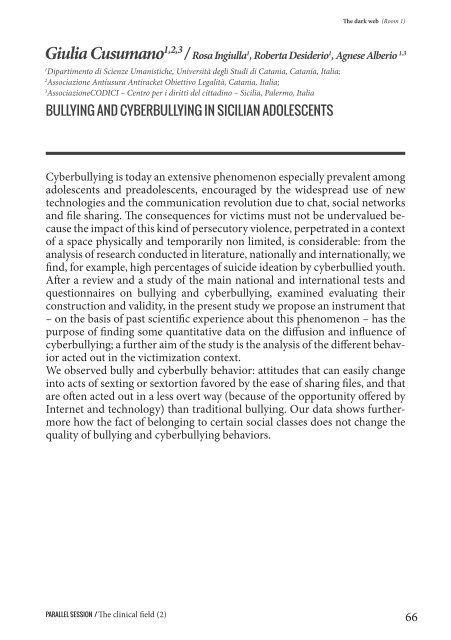pieghevole
You also want an ePaper? Increase the reach of your titles
YUMPU automatically turns print PDFs into web optimized ePapers that Google loves.
The dark web (Room 1)<br />
Giulia Cusumano 1,2,3 / Rosa Ingiulla 1 , Roberta Desiderio 1 , Agnese Alberio 1,3<br />
1<br />
Dipartimento di Scienze Umanistiche, Università degli Studi di Catania, Catania, Italia;<br />
2<br />
Associazione Antiusura Antiracket Obiettivo Legalità, Catania, Italia;<br />
3<br />
AssociazioneCODICI – Centro per i diritti del cittadino – Sicilia, Palermo, Italia<br />
BULLYING AND CYBERBULLYING IN SICILIAN ADOLESCENTS<br />
Cyberbullying is today an extensive phenomenon especially prevalent among<br />
adolescents and preadolescents, encouraged by the widespread use of new<br />
technologies and the communication revolution due to chat, social networks<br />
and file sharing. The consequences for victims must not be undervalued because<br />
the impact of this kind of persecutory violence, perpetrated in a context<br />
of a space physically and temporarily non limited, is considerable: from the<br />
analysis of research conducted in literature, nationally and internationally, we<br />
find, for example, high percentages of suicide ideation by cyberbullied youth.<br />
After a review and a study of the main national and international tests and<br />
questionnaires on bullying and cyberbullying, examined evaluating their<br />
construction and validity, in the present study we propose an instrument that<br />
– on the basis of past scientific experience about this phenomenon – has the<br />
purpose of finding some quantitative data on the diffusion and influence of<br />
cyberbullying; a further aim of the study is the analysis of the different behavior<br />
acted out in the victimization context.<br />
We observed bully and cyberbully behavior: attitudes that can easily change<br />
into acts of sexting or sextortion favored by the ease of sharing files, and that<br />
are often acted out in a less overt way (because of the opportunity offered by<br />
Internet and technology) than traditional bullying. Our data shows furthermore<br />
how the fact of belonging to certain social classes does not change the<br />
quality of bullying and cyberbullying behaviors.<br />
PARALLEL SESSION / The clinical field (2)<br />
66











